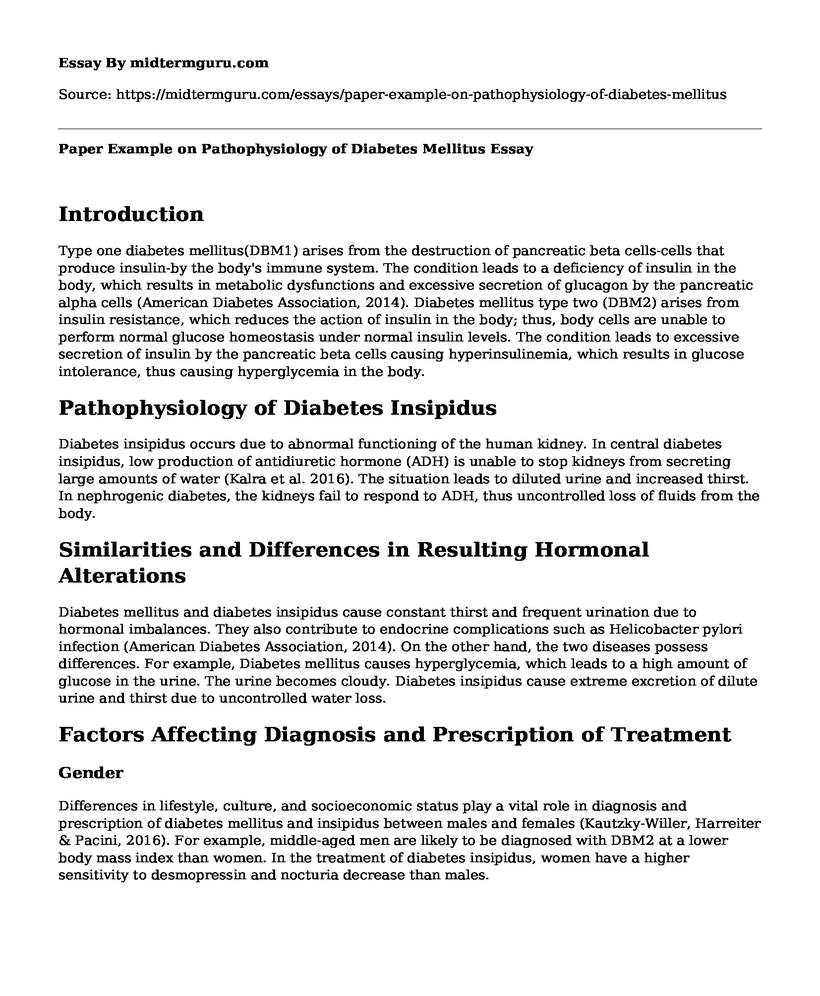Introduction
Type one diabetes mellitus(DBM1) arises from the destruction of pancreatic beta cells-cells that produce insulin-by the body's immune system. The condition leads to a deficiency of insulin in the body, which results in metabolic dysfunctions and excessive secretion of glucagon by the pancreatic alpha cells (American Diabetes Association, 2014). Diabetes mellitus type two (DBM2) arises from insulin resistance, which reduces the action of insulin in the body; thus, body cells are unable to perform normal glucose homeostasis under normal insulin levels. The condition leads to excessive secretion of insulin by the pancreatic beta cells causing hyperinsulinemia, which results in glucose intolerance, thus causing hyperglycemia in the body.
Pathophysiology of Diabetes Insipidus
Diabetes insipidus occurs due to abnormal functioning of the human kidney. In central diabetes insipidus, low production of antidiuretic hormone (ADH) is unable to stop kidneys from secreting large amounts of water (Kalra et al. 2016). The situation leads to diluted urine and increased thirst. In nephrogenic diabetes, the kidneys fail to respond to ADH, thus uncontrolled loss of fluids from the body.
Similarities and Differences in Resulting Hormonal Alterations
Diabetes mellitus and diabetes insipidus cause constant thirst and frequent urination due to hormonal imbalances. They also contribute to endocrine complications such as Helicobacter pylori infection (American Diabetes Association, 2014). On the other hand, the two diseases possess differences. For example, Diabetes mellitus causes hyperglycemia, which leads to a high amount of glucose in the urine. The urine becomes cloudy. Diabetes insipidus cause extreme excretion of dilute urine and thirst due to uncontrolled water loss.
Factors Affecting Diagnosis and Prescription of Treatment
Gender
Differences in lifestyle, culture, and socioeconomic status play a vital role in diagnosis and prescription of diabetes mellitus and insipidus between males and females (Kautzky-Willer, Harreiter & Pacini, 2016). For example, middle-aged men are likely to be diagnosed with DBM2 at a lower body mass index than women. In the treatment of diabetes insipidus, women have a higher sensitivity to desmopressin and nocturia decrease than males.
Age
People between the age of forty-five and sixty-four are the most diagnosed with diabetes (Kautzky-Willer, Harreiter & Pacini, 2016). However, factors such as lifestyle and genetics cause a variation between the age of diagnoses and disease onset. At the age of forty-five, doctors encourage adults to undertake annual diabetes screening.
References
American Diabetes Association. (2014). Diagnosis and classification of diabetes mellitus. Diabetes Care, 37(Supplement 1), S81-S90.
Kalra, S., Zargar, A. H., Jain, S. M., Sethi, B., Chowdhury, S., Singh, A. K., & Malve, H. (2016). Diabetes insipidus: The other diabetes. Indian Journal of Endocrinology and Metabolism, 20(1), 9.
Kautzky-Willer, A., Harreiter, J., & Pacini, G. (2016). Sex and gender differences in risk, pathophysiology and complications of type 2 diabetes mellitus. Endocrine Reviews, 37(3), 278-316.
Cite this page
Paper Example on Pathophysiology of Diabetes Mellitus. (2022, Sep 07). Retrieved from https://midtermguru.com/essays/paper-example-on-pathophysiology-of-diabetes-mellitus
If you are the original author of this essay and no longer wish to have it published on the midtermguru.com website, please click below to request its removal:
- Essay on Drugs and Crime
- Article Analysis Essay on "Quality Improvement in Public Health: Lesson From the Multi-state Learning Collaborative"
- Personal Statement on Doctorate in Clinical Social Work
- Sanofi: A Global Leader in Pharmaceuticals - Essay Sample
- Essay Sample on Organ Donation
- Acadia Pharmaceuticals: Innovative Treatments for Central Nervous System Disorders - Essay Sample
- Obesity in USA: A Potential Cause of Dementia in Elderly? - Essay Sample







